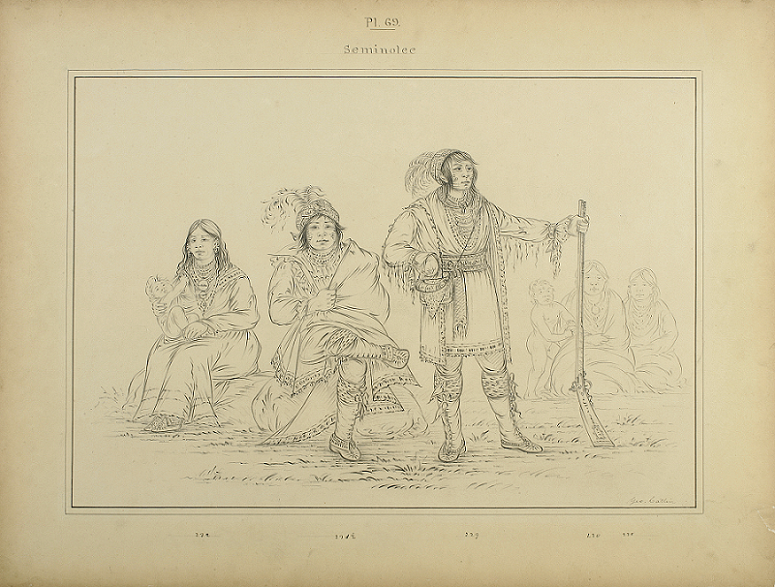Document Text |
Summary |
|
“On the morning of the 12th, near the Econsionah, or Natural Bridge, a party of Indians were discovered on the margin of a swamp and attacked by General McIntosh and about 50 Tennessee volunteers, who routed them, killing 37 warriors and capturing six men and 97 women and children; also recapturing a white woman who had been taken at the massacre of Scott. The friendly Indians also took some horses, and about 500 head of cattle from the enemy, who proved to be McQueen’s party. Upon the application of an old woman of the prisoners, I agreed, that if McQueen was tied and carried to the commandant of St. Marks, her people should be received in peace, carried to the upper tribes of the Creek Nation, and there provisioned until they could raise their own crops. She appeared much pleased with these terms, and I set her at liberty with written instructions to the commandant of St. Marks to that effect. Having received no father intelligence from McQueen, I am induced to believe the old woman has complied with her part of the obligation.”
|
On April 12, a party of Seminole were ambushed by General McIntosh near the Natural Bridge. Thirty seven Seminole warriors were killed. Six warriors and 97 women and children were captured. We also freed a white woman the Seminole had captured in an earlier raid. Our Indigenous allies took some horses and cattle. Unfortunately, their leader escaped. An old woman offered to help me catch their leader if I promised to help her community move to Georgia. I gave her a letter outlining our agreement and set her free. Since she left, I haven’t heard about the leader, so I think she kept her promise. |
Andrew Jackson to John C. Calhoun, April 20, 1818, “Of the Seminole War: Special Documents Transmitted by the President to Congress,” December 29, 1818, New York Spectator.
Background
In the colonial and early periods of U.S. history, many self-emancipated people from Georgia and the Carolinas took refuge in Seminole towns in Spanish Florida. They became known as the Black Seminoles, and they worked closely with the Indigenous Seminoles to help protect their lands and freedom. This enraged white Americans. They called on the government to destroy these refuges.
In 1816, U.S. soldiers destroyed a Seminole garrison that was known to house a large community of self-emancipated people, killing 270 Seminole and Black Seminole people. The Seminole retaliated by raiding U.S. settlers who lived along the Georgia and Florida border. In 1817, a full battle took place at the Seminole village of Fowltown. Historians consider this the official beginning of the First Seminole War.
In December 1818, General Andrew Jackson was given command of the U.S. troops fighting the Seminoles. Over the next six months, he invaded Spanish Florida and destroyed several Seminole villages. However, he did not achieve any real victory over the Seminoles. Jackson’s successes convinced Spain to give the Florida territory to the United States in 1819. But there were two more wars between the United States and the Seminole before they were finally defeated in 1858.
About the Image
The drawing by George Catlin shows us the clothing worn by Seminole people in the first half of the 19th century. In the letter, General Andrew Jackson describes an encounter he had with a Seminole woman early in his campaign in Spanish Florida. Jackson had just achieved a victory against the Seminoles, but his troops failed to capture their leader. One of the women captured during the fighting offered to convince her people to turn over their leader if Jackson would help them move to Georgia and start a new settlement. Jackson eagerly agreed, but the woman was never heard from again. She may have made the offer simply to escape imprisonment.
Vocabulary
- Black Seminole: The name given to self-emancipated people who formed maroon societies in Spanish Florida and fought alongside the Seminole to defend their land and freedom. Descendants of the original Black Seminole people still call themselves by the name, but they have been denied official tribal inclusion by the three Seminole nations.
- garrison: Troops stationed in a fort or town to defend it.
- self-emancipated: People who have freed themselves from slavery, usually by running away or purchasing their freedom.
- Seminole: Name for an Indigenous community that originally inhabited lands that span modern-day Georgia, Alabama, and Florida. Today, there are large Seminole communities in Florida and Oklahoma.
Discussion Questions
- What can we learn about the Seminoles by studying the clothing and accessories worn by the subjects of the drawing by George Catlin?
- Why was Andrew Jackson eager to make a deal with the Seminole woman who offered to help him?
- How do you think Andrew Jackson’s experiences in this war influenced his policies when he became president of the United States?
Suggested Activities
- APUSH Connection: 4.8 Jackson and Federal Power
- Use these sources in any lesson about the U.S. acquisition of Florida.
- Black Seminoles are an example of a Maroon society. To learn more about Maroon societies, read Maroons in the Great Dismal Swamp.
- For a larger lesson about Indigenous communities’ relations with the United States in the Federal period, combine this resource with any of the following: Making Treaties, Washington’s Captives, The Battle of Fort Dearborn, Life Story: Sacagawea, Life Story: Lydia Carter, and Life Story: Harriet R. Gold Boudinot.
- To learn more about how Indigenous women responded to the crisis of colonization and settlement across the Americas, see any of the following: Life Story: Weetamoo, Life Story: Quashawam, Life Story: The Gateras of Quito, Life Story: Malitzen, Life Story: Kateri Tekakwitha, Life Story: Margeuritte Faffart, Life Story: Toypurina, and Life Story: Nanyehi Nancy Ward.
Themes
POWER AND POLITICS







